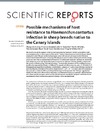Identificador persistente para citar o vincular este elemento:
https://accedacris.ulpgc.es/jspui/handle/10553/20867
| Título: | Possible mechanisms of host resistance to Haemonchus contortusinfection in sheep breeds native to the Canary Islands | Autores/as: | Guo, Zhengyu González, Jorge Francisco Hernández Vega, Julia Natividad McNeilly, Tom N. Corripio-Miyar, Yolanda Frew, David Morrison, Tyler Yu, Peng Li, Robert W. |
Clasificación UNESCO: | 310902 Genética 240108 Genética animal |
Palabras clave: | Quantitative Trait Loci Gastrointestinal Nematodes Parasite Resistance Dorper Sheep Red Maasai, et al. |
Fecha de publicación: | 2016 | Publicación seriada: | Scientific Reports | Resumen: | Haemonchus contortus appears to be the most economically important helminth parasite for small ruminant production in many regions of the world. The two sheep breeds native to the Canary Islands display distinctly different resistant phenotypes under both natural and experimental infections. Canaria Hair Breed (CHB) tends to have significantly lower worm burden and delayed and reduced egg production than the susceptible Canaria Sheep (CS). To understand molecular mechanisms underlying host resistance, we compared the abomasal mucosal transcriptome of the two breeds in response to Haemonchus infection using RNAseq technology. A broad range of mechanisms have evolved in resistant CHB to provide protection against the parasite. Our findings suggest that readily inducible acute inflammatory responses, complement activation, accelerated cell proliferation and subsequent tissue repair, and immunity directed against parasite fecundity all contributed to the development of host resistance to parasitic infection in the resistant breed. | URI: | https://accedacris.ulpgc.es/handle/10553/20867 | ISSN: | 2045-2322 | DOI: | 10.1038/srep26200 | Fuente: | Scientific Reports [ISSN 2045-2322], v. 6 (26200) | Derechos: | by-nc-nd |
| Colección: | Artículos |
Los elementos en ULPGC accedaCRIS están protegidos por derechos de autor con todos los derechos reservados, a menos que se indique lo contrario.
